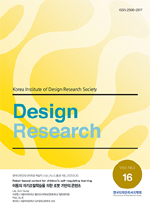- 영문명
- Designing VR Experiences through an Ergonomic Approach : Redesigning Facial Interfaces by Race and Gender
- 발행기관
- 한국디자인리서치학회
- 저자명
- 김소연(Soyeon Kim) 유혜진(Hyejin Yu) 박수빈(Subin Park) 이상원(Sangwon Lee)
- 간행물 정보
- 『한국디자인리서치』Vol10, No. 3(통권 36권), 644~657쪽, 전체 14쪽
- 주제분류
- 예술체육 > 미술
- 파일형태
- 발행일자
- 2025.09.30

국문 초록
본 연구는 가상현실(Virtual Reality, VR) 헤드 마운트 디스플레이(HMD) 경험에서 인종과 성별의 차이가 페이스 인터페이스 디자인과 사용자 경험(몰입감·현존감·시뮬레이터 멀미)에 미치는 영향을 규명하고, 이에 기반한 맞춤형 설계 지침을 제시하는 것을 목적으로 한다. 특히, 아시아인의 인체 계측을 반영한 새로운 인터페이스를 기존 디자인과 비교하기 위해 Hsiao의 인체측정 설계 6단계 절차를 적용하여 네 가지 인터페이스를 설계·제작하였다. 새롭게 설계된 인터페이스는 (1) 기존 Oculus Quest 2 패턴을 평균 대비 표준편차 범위를 반영해 스케일링한 Small/Medium/Large 모델과 (2) 한국인 평균 두상 특성을 고려해 이마와 코 부분을 재비례화한 ‘Best Fit’ 모델을 포함한다. 실험에는 20–30대 한국인 41명(남 19, 여 22)과 caucasian (백인 혈통) 39명(남 20, 여 19) 등 총 80명이 참여하였으며, 사전에 얼굴 치수(머리 둘레·길이·너비·광대뼈 간 거리)를 계측하였다. 참가자들은 기존 인터페이스와 새롭게 설계된 인터페이스를 각각 착용해 동일한 가상현실 게임을 체험하였고, 각 체험 종료 후 몰입감·현존감·시뮬레이터 멀미(SSQ) 설문과 반구조화 인터뷰를 수행하였다. 연구 결과, 인종과 성별에 따라 새로운 인터페이스 착용 시 몰입감과 현존감 점수에서 유의한 차이가 확인되었으며, 이를 통해 맞춤형 페이스 인터페이스의 필요성이 뚜렷하게 제시되었다. 특히, 광대뼈 너비와 머리 길이를 조정한 압력 분산 구조는 몰입감과 현존감을 향상시키고 시뮬레이터 멀미를 완화할 가능성을 보여주었다. 본 연구는 다양한 인종 및 성별의 특성을 반영한 맞춤형 페이스 인터페이스 디자인의 중요성을 강조하며, 향후 VR 기기 개발 과정에서 사용자 경험에 최적화된 인체공학적 데이터를 체계적으로 활용할 수 있는 기초 자료를 제공한다.
영문 초록
This study investigates how racial and gender differences affect virtual reality head-mount display's user experience, especially in immersion, presence, and simulator sickness. Applying Hsiao’s six-step anthropometric design paradigm, four interfaces were developed: (1) Small, Medium, and Large models scaled from the Oculus Quest 2 pattern by standard deviation ranges, and (2) a “Best Fit” model reflecting average Korean craniofacial features with re-proportioned forehead and nasal regions. Eighty participants in their 20s and 30s (41 Korean, 39 Caucasian) were recruited, and craniofacial measurements (head circumference, length, breadth, and bizygomatic breadth) were collected. Each participant experienced the same VR game using both the existing and newly designed interfaces, followed by immersion, presence, and SSQ questionnaires and semi-structured interviews. Results showed significant racial and gender differences in immersion and presence with the new interfaces, highlighting the need for customized designs. Notably, modifications to cheekbone width and head length improved immersion and presence while reducing simulator sickness. These findings underscore the importance of ergonomic, demographically informed design for VR HMD face interfaces and provide baseline data for user-centered device development.
목차
1. 서론
2. 이론적 배경
3. 실험 방법
4. 결과
5. 논의
6. 결론 및 추가논의 사항
참고문헌
해당간행물 수록 논문
참고문헌
최근 이용한 논문
교보eBook 첫 방문을 환영 합니다!

신규가입 혜택 지급이 완료 되었습니다.
바로 사용 가능한 교보e캐시 1,000원 (유효기간 7일)
지금 바로 교보eBook의 다양한 콘텐츠를 이용해 보세요!



